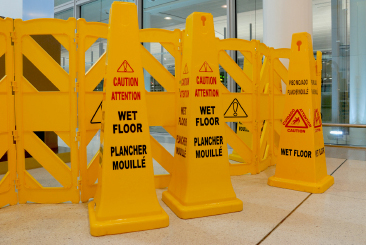|
|
| Selecting a Floor Machine with a KISS |
| By Mike Schaffer |
| Published: 07/12/2010 |
 In the last few years, manufacturers in the professional cleaning industry have introduced a number of new floor machines, automatic scrubbers, and burnishers designed to make floor care easier, faster, and Greener. These new machines are being introduced in all sizes, designs, and price points.
In the last few years, manufacturers in the professional cleaning industry have introduced a number of new floor machines, automatic scrubbers, and burnishers designed to make floor care easier, faster, and Greener. These new machines are being introduced in all sizes, designs, and price points.
However, some of the new machines are so new that many end customers are not sure which machine is best for them and their floor-care needs. Although it is exciting that new floor-care technologies are evolving, it must be admitted that at this time, it may also be causing some end-customer confusion. Large facilities, such as correctional facilities are unsure if they should select some new technology now or hold off until it has been around for a while, waiting to hear what others have to say about the machine. And the severe restrictions on correctional facility budgets have made selecting any new technology, especially if it is a more expensive technology, all the more difficult. The answer to the dilemma? Now is the best time to use the KISS formula when selecting floor-care equipment: Keep It Simple…and Straightforward. KISS…in Practice As it relates to automatic scrubbers and other types of floor-care equipment, the KISS formula involves the following five concepts, all of which are critical to proper, cost-efficient, and environmentally responsible floor care:
Unless the selected floor machine has been designed to perform without water, automatic scrubbers do require some cleaning solution, Green or conventional, to achieve the best results. By thoroughly removing soils, the look and life span of the floor are improved. Many chemical manufacturers now have cleaning agents that perform exceptionally well on floors. Although this includes environmentally preferable chemicals, most users and their distributors suggest trying brands made by different manufacturers before finalizing a selection. As to finishes, many now have high solid content that resists wear, requires fewer coats (which helps cut costs), and leaves a tough, high-gloss shine. Additionally, many of these finishes can be high-speed burnished or spray buffed using a lower speed machine to quickly restore shine and gloss. Correctional facility managers should also be aware of one more thing when it comes to chemicals. Many floor-care products are designed by manufacturers to work better together. For instance, a manufacturer may formulate cleaning agents and other chemicals to work well with their finishes and other floor-care products. It’s often a good idea to test a manufacturer's cleaning and scrubbing chemical solutions first. If these perform satisfactorily, then try their other floor-care glosses and finishes. Final Thoughts No matter what type of automatic scrubber has been selected, some basic care and maintenance issues apply to all machines. First and paramount to ensuring best-practice use of equipment is training. Many distributors will take the time to teach users how to properly operate the machine. This includes not only the actual scrubbing and cleaning function but also the correct start-up and shut-down procedures for the machine as well as instruction on how to service those items that can be repaired or adjusted in-house. Automatic scrubbers should be inspected on a set schedule. Often this is best accomplished by having a log “checkoff” system. This formalizes the process and ensures that the machine is checked frequently and as scheduled. If a problem is noted, it should be listed on the log, dated, and brought to supervisory attention. Also, there are some safety issues in regards to storing floor-care chemicals and finishes. Cleaning chemicals can create hazardous conditions, and even storing certain types of cleaning chemicals together can increase the likelihood that a health threat may arise. This is because chemicals can release fumes that when mixed with other fumes, can cause hazardous chemical reactions. A good policy is to store large quantities of cleaning chemicals by type in a safe, secure, out of the way location. Place smaller and more limited quantities of chemicals in facility working areas and janitorial closets. With both floor-care machines and chemicals, make sure the equipment is used and operated per the manufacturers' recommendations, mixing directions, and guidelines. Failure to do so not only can hamper performance and results but also may result in an injury, risk the safety of others in the facility, and even void the equipment’s warranty. Mike Schaffer is president of Tornado® Industries, a leading manufacturer of professional cleaning equipment. Sidebar: Battery Maintenance The following are some routine battery maintenance tips to keep floor machine batteries in tip-top condition:
*An automatic scrubber is a floor machine designed to perform three functions, all in one pass: apply cleaning solution to the floor, scrub the floor, and then vacuum dry and squeegee the floor. |
MARKETPLACE search vendors | advanced search

IN CASE YOU MISSED IT
|


Comments:
No comments have been posted for this article.
Login to let us know what you think